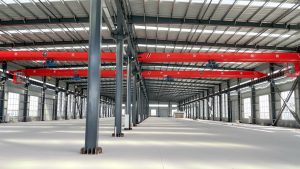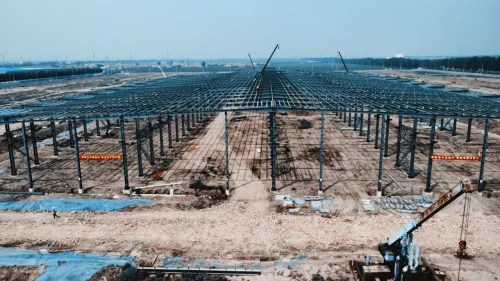Steel Portal Frame
In steel building systems — especially pre-engineered buildings (PEB) or large-span steel structures — primary framing components are the main load-bearing members that carry and transfer loads (dead load, live load, wind, seismic) to the foundation.
Portal frame systems can be adapted to different architectural styles and can accommodate various cladding materials, including metal, concrete, or glass.
Main Primary Framing Components
|
Component |
Description |
Function |
|---|---|---|
|
Main Frame (Rigid Frame) |
Includes columns and rafters made from hot-rolled or welded H-sections. |
Forms the building’s skeleton; resists vertical and lateral loads. |
|
Columns |
Vertical primary members (tapered or straight). |
Transfer roof and sidewall loads to foundation. |
|
Rafters |
Sloped horizontal members connecting the tops of columns. |
Carry roof loads to columns. |
|
Eave Struts |
Horizontal members at the eave line, sometimes considered secondary but can be part of the primary frame in certain designs. |
Connect wall and roof systems, help transfer loads. |
|
Girts & Purlins (Secondary) |
Not part of primary load-bearing frame but support cladding. |
Distribute loads to primary members. |
Typical Types of Primary Frames
-
Clear Span Rigid Frame: No interior columns; wide open space.
-
Multi-Span Rigid Frame: Interior columns to support very large spans.
-
Single Slope Rigid Frame: One side higher than the other for drainage.
-
Tapered Beam Frame: For small to medium span buildings.
-
Lean-To Frame: Attached to main frame for additional space.
Characteristics
-
Material: Commonly welded H-section steel (Q355B, ASTM A572 Gr.50, etc.).
-
Connections: Bolted at site, welded in factory.
-
Surface Treatment: Painted or galvanized to prevent corrosion.
Load Path
-
Roof & wall cladding transfer loads
-
Secondary members (purlins, girts)
-
Primary framing (rafters, columns)
-
Anchor bolts & foundation




Reviews
There are no reviews yet.